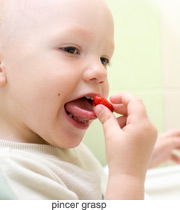
Baby led weaning, or baby led solids, is a really simple concept and just means letting your baby feed himself when he is ready for solids. Most Americans think of weaning as giving up breastfeeding, but in the UK where the term “baby led weaning” originated, weaning means the transition to solid foods.
When most parents are ready to introduce their baby to solids, they start off by feeding their baby rice cereal or pureed fruits and vegetables from a spoon. With baby led weaning, the parent’s role in feeding is more hands-off. Rather than mom feeding the baby with a spoon, the baby feeds himself.
The baby led weaning idea got its start with Gill Rapley, a British writer and public health nurse (called health visitors in the UK). Her book Baby-Led Weaning: Helping Your Baby to Love Good Food discusses the rationale for taking a baby-led approach to starting solids. It also includes guidelines as well as dos and don’ts for parents who want to use this method to introduce solids to their babies.
Starting Solids
There is some debate about when babies are ready for solids. The American Academy of Pediatrics (AAP) Committee on Nutrition recommends starting solids sometime between 4 and 6 months. Before then, babies lack the skills necessary for swallowing. Instead of swallowing food, they will push it out with their tongue. There are no rules on which solids babies should have first, but most parents start with a single-grain cereal and pureed veggies. Fruits are usually given later so that infants don’t develop a preference for sweets.

Baby Led Solids
Parents that follow the baby led weaning approach, along with many experts, believe that babies’ digestive systems are not ready for solids until they are around six months old. This is one of the reasons why parents that follow this method delay solids until their babies are six months or older. By waiting until baby is six months, you can start your baby on solids that he can pick up and eat all by himself. There is no need to start with cereals and mushed up food because at this age he is more coordinated. He can use his hands to pick up food and put it in his mouth. His oral-motor coordination is better too. He should be able to chew (or gum) food and swallow it without any help.
By waiting until baby can feed himself, you are not only protecting his delicate digestive system but also giving him an opportunity to discover and explore food on his own, set his own pace for eating, and be part of the family meal time experience. A baby that is spoon fed has less control over how much food he takes in. The feeder controls the pace and decides when the baby is done instead of the baby. A baby that feeds himself can decide what he wants to eat and how much of it he wants to eat.
How to Get Started With Baby Led Solids
 Include your baby in family meal time: When the family is enjoying meal time put your baby in his high chair facing the table so that he can be part of the family meal. You can start letting him be part of meal time even before you start offering solids by letting him sit in your lap or sit in his high chair close by.
Include your baby in family meal time: When the family is enjoying meal time put your baby in his high chair facing the table so that he can be part of the family meal. You can start letting him be part of meal time even before you start offering solids by letting him sit in your lap or sit in his high chair close by.
Watch for cues: When your baby is interested in solids he may start to stare at your food or try to grab food from your plate. This is his way of letting you know that he’s interested in trying solids.
Offer soft finger foods baby can grasp with his fist: Since your baby has not developed a pincer grasp yet (this skill is usually mastered around 7-11 months), he needs foods that he can clutch in his fist. It’s easier for babies to eat foods that are spear shaped or have a handle to grab onto, like steamed broccoli spears.
What about choking? By this age your baby should be able to chew and swallow. He is no more likely to choke using baby led weaning than if he had started with pureed foods first. If your baby has developmental delays that might make grasping, chewing, or swallowing difficult, you should consult your doctor before trying baby led weaning.
Offer a variety of finger foods: Offer your baby different textured and tasting foods. By doing this you can hopefully avoid issues with picky eating down the road. If your baby doesn’t like something the first time, offer it again. Feeding experts say that it takes 12 or more exposures to a food before a baby will acquire a taste for it.
Let your baby be: This is your baby’s opportunity to discover new tastes and textures. Offer the food to him, but don’t help him with it. Let him decide which pieces of foods he wants to try and how much he wants to eat.
